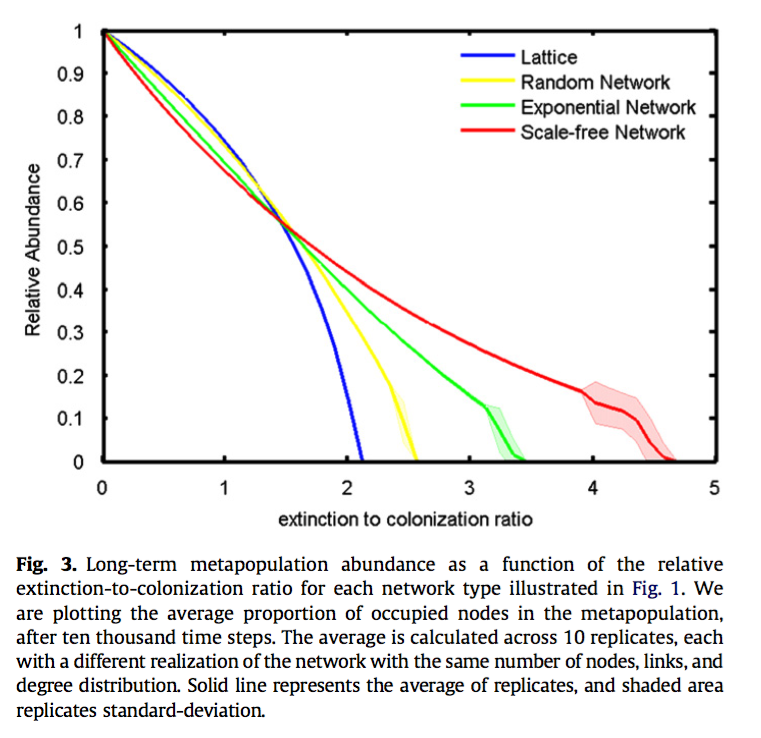Spatial network structure and metapopulation persistence
Network structure is being increasingly applied to the study of metapopulations, as a spatially explicit way to better characterize how populations are connected to each other via dispersal. Aspects of network structure such as the number of nodes, or their connection patterns (average number of connections across nodes, or variability in the number of connections) have been found to be important for dynamics of metapopulations. Metapopulation persistence in these types of networks that is of practical interest, as it has relevance in to extinction risk and management of populations on fragmented landscapes. Gillarranz and Bascompte compare networks with different topologies (regular, random, exponential, and scale-free) to determine what structural features are most important for metapopulation persistence and regional abundance (the number of occupied patches divided by total patches). These types of networks represent a spectrum of variance in node degree (the number of linkages between a node and other nodes) moving from constant node degree in regular networks to more and more variance in random, exponential, and scale-free networks, respectively). They used a discrete, spatially explicit Levins’ (1969) model, with patches that become extinct with a certain probability, and unoccupied patches that become colonized at a certain probability by one of the occupied patches that they are connected to in the network.
They found that networks with greater variability in node degree had higher persistence for a given extinction to colonization ratio (persistence to extinction threshold = x intercept in Fig. 3). However, the qualitative effects of network structure on regional abundance varied depending on the extinction to colonization (e/c) ratio. At a ratio of 1.5, more homogeneous networks had slightly higher regional abundances, but this pattern was the opposite once e/c was greater than 1.5 (and thus higher variance networks persist for a larger range of e/c ratios). Thus, there was a tradeoff between metapopulation persistence and regional abundance across network types for certain values of e and c. Therefore, from a conservation perspective, knowledge of a species’ life history traits that influenced its likelihood of extinction in a patch versus its dispersal would therefore be important in deciding the most effective spatial structure for protected areas and/or corridors for conserving that species.

Additionally, the authors found that Incidence, or the proportion of time steps that a node was occupied, was more variable across nodes in networks with higher variance in node degree (but only for high e/c ratios). This dependency of incidence on node degree was a nonlinear relationship, such that after a threshold in degree connection, there is no increase in incidence with degree. Additionally, patches that were connected to high-degree patches had higher incidence compared to patches of the same degree that were connected to low-degree patches. These results mean that both general network structure (like degree variance) and the position of a patch in a network are important for determining its likelihood of being occupied at any given time.
Gilarranz, L. J. & Bascompte, 2012. J. Spatial network structure and metapopulation persistence. Journal of Theoretical Biology 297, 11–16.
